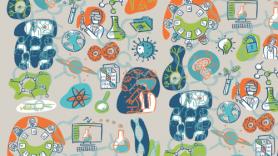3. From indicators to funding, including society
The main way science (and a scientific career) is judged today is with bibliographic indicators. Some of the sacred metrics are the impact factor of journals in which the papers are published (which has to do with the number of times previous articles have been cited) and the author's H index (also based on the number of times their research is referenced in journals).
Nevertheless, these seem clearly insufficient. And criticism of their indiscriminate use is only growing.
"These metrics measure anything but what we want to measure. They certainly don't determine the quality of the science," said von Schomberg. For Ismael Ràfols, researcher at Ingenio (Instituto de Gestión de la Innovación y el Conocimiento), "indicators shouldn't be the basis of evaluating science. They should be at the bottom of the list of criteria, not at the top." Not even the new models proposed, such as social media indicators (Altmetrics) that assess the number of times articles are downloaded, mentioned or shared online or on social media, are sufficiently robust. "They're interesting to explore the context and audience for the articles, but they aren't general indicators."
Ràfols advocates for shifting focus away from production and towards processes to share knowledge, assuming there are no universal indicators and that they must fit the context of the research and its communication. "Science is like a biosphere with different ecosystems. If we choose one indicator, we may be encouraging just one of them. This is why we should focus on those that encourage diversity without compromising production."
The classic indicators are also one of the pillars of assessing projects and assigning funding. This process concerns not only funding agencies also scientists themselves, and is strongly criticized by Johan Bollen, professor at the Indiana University, United States. "It takes a lot of time and money to draft proposals that will mostly be rejected," he said (up to one fourth of the total of a European program may be spent on preparing applications, according to Bollen). Plus, "assessments can't predict productivity and they are particularly unfair to young people, women and those with more innovative projects."
Bollen has developed a radical proposal: a sort of (scientific) universal basic income. This idea would give each researcher, simply for being one, a fixed amount each year. In the United States, dividing the total investment by the number of head researchers would mean each one would get a base of $250,000, according to Bollen. After that, each one could donate a percentage to another research group anonymously. So, the scientists themselves redistribute the funding and no one goes without.
With certain adjustments and corrections to prevent bias, this would have many advantages, according to Bollen. It would allow scientists to devote all of the hours that currently go into drafting grant proposals to research. It would foster innovation, as all researchers would have a basic income and this would allow them to take on projects with greater risk. It would promote more open science, because groups would see the direct advantages of expanding their network of collaborations and raising awareness of their work for others to assess (and fund) it. It would prevent lines of research from being decided by small assessment panels and it would open up distribution of resources to the whole network of scientists.
However, he does recognize this would limit society's participation in the decision-making process.
About RRI (Responsible Research Innovation) and citizen science
Open-innovation proposals for some time now have used a model called the 'quadruple helix', which advocates for joint participation from four different stakeholders: public administrations, academia, industry and society. The final group should be increasingly involved, both in some research processes and in the decision-making process.
One of the ways to bridge this gap is through what are called 'Labs', where users are directly involved in the creation and innovation process. "It's the new meme. Everything that used to be net now wants to be lab," joked Artur Serra, deputy director of i2cat and vice-president of the European Network of Living Labs. Serra presented some of the initiatives being promoted in Catalonia, like the BiblioLab, Ciència Ciutadana en Acció, BCN Lab and the Barcelona Citizen Science Office.
In addition to co-creation processes, many citizen science initiatives have to do with public health research, specifically for emergency situations. And they not only bring science to society, they have a direct effect on it. "Open science in real time saves lives," stressed von Schomberg. "Many of the achievements in terms of Ebola and Zika wouldn’t have been possible if the research had been focused competitively. But these mechanisms should be expanded to many other arenas."
The concept of RRI is increasingly popular, but Marion Dreyer, deputy scientific director at DIALOGIK in Stuttgart, regrets that there has not been a firmer commitment to this in Europe. Despite the push for open science, "European programs don't have a specific framework or budget for it." And, according to René von Schomberg, "open science is a necessary condition for responsible innovation, but it is not enough on its own."
Issues with access to publications, reproducibility, assessment and funding methods, true utility, and the role of citizens in the processes and results; open science must try to give specific alternatives and solutions to the problems facing science today. To influence this, B·Debate participants met in breakout sessions focused on each of these topics.
Their conclusions and recommendations will be published soon with the firm commitment to promoting this in Catalonia, Spain and Europe.



